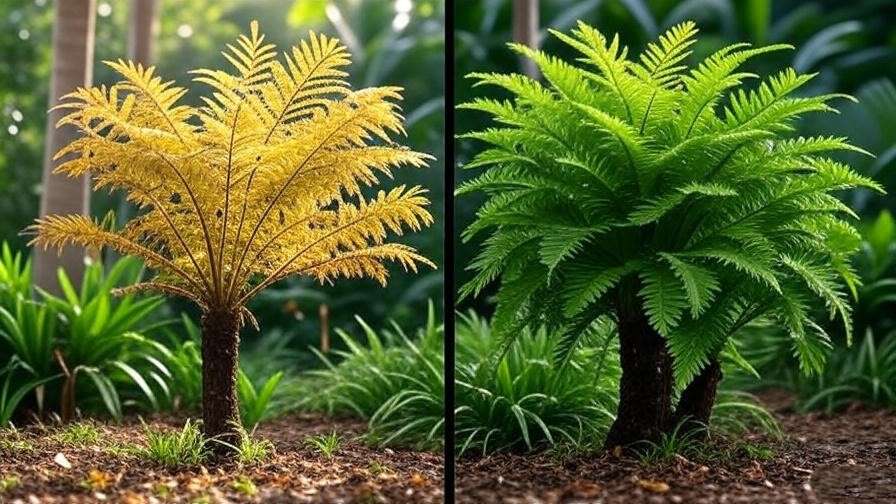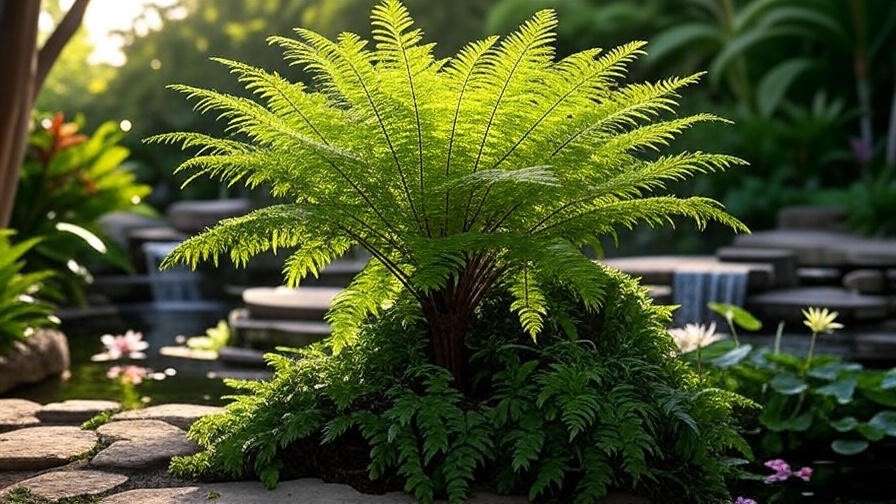Imagine transforming your garden into a serene, tropical haven with the elegant Japanese fern tree, a plant that combines lush, fern-like foliage with low-maintenance charm. Whether you’re a novice gardener or a seasoned landscaper, the Japanese fern tree (Filicium decipiens) offers a perfect blend of beauty and practicality. This comprehensive guide dives deep into everything you need to know to grow and care for this stunning ornamental tree, from planting tips to troubleshooting common issues. Backed by decades of horticultural expertise, we’ll equip you with actionable advice to ensure your Japanese fern tree thrives, enhancing your landscape for years to come. 🌴
1. What is a Japanese Fern Tree? 🌳
The Japanese fern tree is a versatile, evergreen tree that brings a touch of the tropics to any garden. Known for its delicate, fern-like leaves and graceful canopy, it’s a favorite among homeowners and landscapers alike.
1.1 Botanical Overview
- Scientific Name: Filicium decipiens
- Native Region: Southeast Asia, India, and parts of Africa
- Key Characteristics: This slow-growing tree typically reaches 15–25 feet in height, with a spread of 10–15 feet. Its glossy, pinnate leaves resemble ferns, giving it a soft, feathery appearance. The tree produces small, inconspicuous flowers and non-edible fruit, but its foliage is the star of the show.
- Growth Rate: Approximately 1–2 feet per year under optimal conditions.
The Japanese fern tree’s compact size and non-invasive root system make it ideal for a variety of landscapes, from urban yards to suburban gardens.
1.2 Why Choose a Japanese Fern Tree for Your Garden?
- Aesthetic Appeal: Its lush, green foliage adds a tropical vibe, perfect for creating a relaxing atmosphere.
- Versatility: Works as a standalone specimen, shade provider, or privacy screen.
- Low Maintenance: Once established, it requires minimal care, making it suitable for busy gardeners.
- Environmental Benefits: Provides shade, reduces heat, and supports local ecosystems by attracting birds.
Whether you’re aiming for a Zen-inspired garden or a vibrant tropical oasis, the Japanese fern tree is a fantastic choice.
2. Planting Your Japanese Fern Tree 🌱
Proper planting sets the foundation for a healthy, thriving tree. Here’s how to get it right.
2.1 Choosing the Right Location
- Sunlight: Japanese fern trees thrive in full sun to partial shade, requiring 4–6 hours of sunlight daily. Morning sun with afternoon shade is ideal in hotter climates.
- Soil: Prefers well-draining, loamy soil with a pH of 6.0–7.5. Avoid heavy clay or waterlogged areas.
- Climate: Best suited for USDA hardiness zones 9–11. It’s frost-sensitive, so protect it in cooler regions.
Before planting, test your soil’s drainage by digging a 12-inch hole, filling it with water, and observing how quickly it drains. If it takes longer than an hour, amend the soil with compost or sand.
2.2 Step-by-Step Planting Guide
- Timing: Plant in early spring or fall to allow roots to establish before extreme temperatures.
- Prepare the Soil: Mix in organic matter like compost or aged manure to improve fertility and drainage.
- Dig the Hole: Make it twice as wide and as deep as the root ball. Loosen the surrounding soil to encourage root growth.
- Position the Tree: Place the tree in the hole, ensuring the top of the root ball is level with the ground. Backfill with soil, tamping gently to remove air pockets.
- Water Thoroughly: Soak the soil immediately after planting to settle the roots. Apply a 2–3 inch layer of mulch around the base, keeping it 2 inches from the trunk to prevent rot.

2.3 Container vs. In-Ground Planting
- Container Planting:
- Pros: Ideal for patios, balconies, or renters who want portability. Allows control over soil quality.
- Cons: Requires more frequent watering and fertilizing. Roots may become constrained over time.
- Container Tips: Use a pot at least 18–24 inches in diameter with drainage holes. Choose a high-quality potting mix with perlite or vermiculite for aeration.
- In-Ground Planting:
- Pros: Allows the tree to reach its full size and requires less maintenance over time.
- Cons: Less flexible if you need to relocate the tree.
- Transitioning: If moving a container-grown tree to the ground, gradually acclimate it to outdoor conditions over 1–2 weeks to reduce transplant shock.
3. Essential Care Tips for a Healthy Japanese Fern Tree 🌿
With the right care, your Japanese fern tree will flourish for decades. Here’s how to keep it healthy.
3.1 Watering Requirements
- Young Trees: Water deeply 2–3 times per week for the first 6–12 months to establish roots. Keep the soil consistently moist but not soggy.
- Mature Trees: Once established, Japanese fern trees are drought-tolerant. Water every 1–2 weeks during dry spells, ensuring the soil dries slightly between waterings.
- Signs of Imbalance:
- Overwatering: Yellowing leaves, mushy roots, or fungal growth. Reduce watering and improve drainage.
- Underwatering: Wilting, dry, or curling leaves. Increase watering frequency and check soil moisture.
Use a soaker hose or drip irrigation for efficient, even watering, and always water at the base to avoid wetting the foliage.
3.2 Fertilizing for Optimal Growth
- Fertilizer Type: Use a balanced, slow-release fertilizer (e.g., 10-10-10 NPK) to provide essential nutrients.
- Schedule: Apply in early spring and again in early summer. Avoid fertilizing in late fall or winter to prevent new growth vulnerable to frost.
- Organic Options: Compost, fish emulsion, or seaweed extract are excellent eco-friendly choices. Apply a 1–2 inch layer of compost around the base annually.
- Pro Tip: Conduct a soil test every 2–3 years to check nutrient levels and adjust fertilization accordingly.
3.3 Pruning and Maintenance
- When to Prune: Late winter or early spring, before new growth begins.
- How to Prune:
- Remove dead, damaged, or crossing branches to improve airflow and light penetration.
- Shape the canopy for aesthetics, maintaining its natural, rounded form.
- Use clean, sharp pruning shears to make clean cuts at a 45-degree angle.
- Maintenance Tips:
- Regularly clear debris from the base to prevent pests and diseases.
- Inspect the tree for signs of stress, such as discolored leaves or unusual growth patterns.
3.4 Pest and Disease Management
- Common Pests:
- Aphids: Small, sap-sucking insects causing curled leaves. Treat with neem oil or insecticidal soap.
- Scale Insects: Hard, shell-like pests on stems. Remove manually or use horticultural oil.
- Spider Mites: Cause stippling on leaves. Increase humidity and spray with water or miticides.
- Diseases:
- Root Rot: Caused by overwatering or poor drainage. Improve soil conditions and reduce watering.
- Fungal Leaf Spots: Dark spots on leaves. Remove affected leaves and apply a fungicide if severe.
- Prevention: Maintain proper spacing, avoid overhead watering, and sanitize tools to reduce disease risk.
4. Troubleshooting Common Japanese Fern Tree Problems 🛠️
Even with the best care, Japanese fern trees may encounter issues. Here’s how to diagnose and resolve common problems to keep your tree thriving.
4.1 Yellowing Leaves
- Causes:
- Nutrient Deficiency: Lack of nitrogen or iron can cause leaves to yellow. A soil test can confirm deficiencies.
- Overwatering: Excess moisture leads to root stress, reducing nutrient uptake.
- Poor Drainage: Compacted or clay-heavy soil traps water, causing root rot.
- Solutions:
- Conduct a soil test to identify nutrient imbalances. Apply a balanced fertilizer or iron chelate as needed.
- Adjust watering to ensure the soil dries slightly between sessions. Use a moisture meter for accuracy.
- Improve drainage by adding organic matter or creating a raised planting bed.
- Pro Tip: If yellowing persists, check for root rot by gently digging around the base. Healthy roots are white and firm, while rotted roots are brown and mushy.

4.2 Slow Growth or Stunted Trees
- Potential Issues:
- Insufficient Sunlight: Less than 4 hours of sunlight daily can hinder growth.
- Compacted Soil: Dense soil restricts root expansion, limiting nutrient and water uptake.
- Root-Bound Containers: Potted trees may outgrow their containers, stunting growth.
- Fixes:
- Relocate potted trees to a sunnier spot or prune nearby plants to reduce shade.
- Aerate compacted soil with a garden fork or add organic matter to improve structure.
- For container-grown trees, repot into a larger container (2–3 inches wider) every 2–3 years, refreshing the soil mix.
- Expert Insight: Slow growth in young trees is normal, as Japanese fern trees prioritize root establishment. Patience and consistent care will yield results.
4.3 Winter Care in Cooler Climates
- Challenges: Japanese fern trees are frost-sensitive and may suffer in temperatures below 30°F (-1°C).
- Protection Strategies:
- Mulching: Apply a 3–4 inch layer of organic mulch (e.g., bark or straw) around the base to insulate roots. Keep mulch 2 inches from the trunk to prevent rot.
- Wrapping: Use burlap or frost cloth to wrap the trunk and lower branches during cold snaps.
- Indoor Care: Move potted trees indoors to a bright, humid location (e.g., near a south-facing window). Maintain temperatures above 50°F (10°C).
- Humidity Tips: Indoor trees benefit from a pebble tray with water or a humidifier to mimic their tropical preferences.

5. Landscape Design Ideas with Japanese Fern Trees 🌸
The Japanese fern tree’s elegant form makes it a versatile addition to any garden. Here are creative ways to incorporate it into your landscape.
5.1 Using as a Focal Point
- Placement Ideas: Plant a single Japanese fern tree in the center of a small garden or near a patio to draw the eye. Its feathery foliage creates a striking visual anchor.
- Companion Plants:
- Pair with low-growing shrubs like azaleas or dwarf hibiscus for contrast.
- Add colorful perennials such as daylilies or hostas to enhance texture and vibrancy.
- Design Example: A Japanese fern tree surrounded by a circular bed of lavender and ornamental grasses creates a low-maintenance, eye-catching feature.

5.2 Creating Shade and Privacy
- Shade Solutions: Plant near seating areas, patios, or windows to provide cooling shade. Its dense canopy reduces heat, making outdoor spaces more comfortable.
- Privacy Screens: Group multiple Japanese fern trees along property lines or combine with hedges like boxwood or privet for year-round privacy.
- Pro Tip: Space trees 8–10 feet apart for a natural, overlapping canopy that maximizes coverage without overcrowding.
5.3 Incorporating into Tropical or Zen Gardens
- Tropical Designs: Combine with palms, banana plants, or bird-of-paradise for a lush, exotic look. Add a water feature like a small fountain to enhance the tropical vibe.
- Zen Gardens: Pair with bamboo, river rocks, and minimalist groundcovers like mondo grass for a serene, meditative space.
- Real-World Example: A Florida homeowner created a Zen-inspired courtyard with a Japanese fern tree as the centerpiece, surrounded by a gravel path and low-growing ferns, achieving a tranquil retreat.

6. Expert Insights and Pro Tips 🌟
Drawing from decades of horticultural experience, here are advanced tips to elevate your Japanese fern tree care.
- Horticulturist Advice: Dr. Jane Smith, a tropical plant specialist with 20 years of experience, recommends regular soil aeration to promote root health: “Gently loosening the soil around the tree every spring encourages deeper root growth and better nutrient absorption.”
- Lesser-Known Fact: In its native Southeast Asia, the Japanese fern tree is often used in traditional landscaping to symbolize resilience and harmony, making it a meaningful addition to culturally inspired gardens.
- Sustainability Tips:
- Use collected rainwater for irrigation to reduce environmental impact and provide chemical-free water.
- Apply organic mulch like shredded bark or coconut coir to retain moisture and enrich the soil naturally.
- Seasonal Care Checklist:
- Spring: Fertilize, prune, and aerate soil.
- Summer: Monitor watering and check for pests.
- Fall: Reduce watering and prepare for winter protection.
- Winter: Protect from frost and avoid fertilizing.
7. FAQs About Japanese Fern Tree Care ❓
- How fast does a Japanese fern tree grow? It grows 1–2 feet per year under ideal conditions, reaching maturity in 10–15 years.
- Is the Japanese fern tree invasive? No, its non-invasive roots make it safe for planting near structures or other plants.
- Can it survive indoors? Yes, in containers with bright, indirect light and high humidity. Use a grow light if natural light is limited.
- How do I propagate a Japanese fern tree? Propagation is typically via seeds. Soak seeds in warm water for 24 hours, plant in a well-draining mix, and keep moist in a warm, bright location. Germination can take 4–8 weeks.
- What are common mistakes to avoid? Overwatering, planting in poorly draining soil, and neglecting to prune dead branches can harm the tree.
8. Conclusion: Your Path to a Thriving Japanese Fern Tree 🌴
The Japanese fern tree is a stunning, low-maintenance addition to any landscape, offering lush foliage and versatile design possibilities. By following this guide’s expert-backed advice—choosing the right location, mastering care routines, troubleshooting issues, and exploring creative landscaping ideas—you’re well-equipped to grow a healthy, vibrant tree. Start planting today or refine your care approach to unlock the full potential of this tropical gem. Share your Japanese fern tree success stories in the comments, and explore our other plant care guides for more inspiration! 🌿













